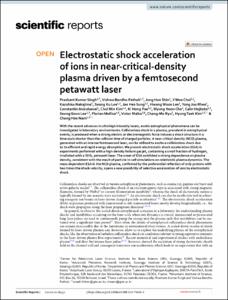GIST Scholar
College of Natural Sciences
Department of Physics and Photon Science
1. Journal Articles
Electrostatic shock acceleration of ions in near-critical-density plasma driven by a femtosecond petawatt laser
- Type
- Article
- Citation
- SCIENTIFIC REPORTS, v.10, no.1
- Issued Date
- 2020-10
- Abstract
- With the recent advances in ultrahigh intensity lasers, exotic astrophysical phenomena can be investigated in laboratory environments. Collisionless shock in a plasma, prevalent in astrophysical events, is produced when a strong electric or electromagnetic force induces a shock structure in a time scale shorter than the collision time of charged particles. A near-critical-density (NCD) plasma, generated with an intense femtosecond laser, can be utilized to excite a collisionless shock due to its efficient and rapid energy absorption. We present electrostatic shock acceleration (ESA) in experiments performed with a high-density helium gas jet, containing a small fraction of hydrogen, irradiated with a 30 fs, petawatt laser. The onset of ESA exhibited a strong dependence on plasma density, consistent with the result of particle-in-cell simulations on relativistic plasma dynamics. The mass-dependent ESA in the NCD plasma, confirmed by the preferential reflection of only protons with two times the shock velocity, opens a new possibility of selective acceleration of ions by electrostatic shock.
- Publisher
- NATURE RESEARCH
- ISSN
- 2045-2322
- Appears in Collections:
- Department of Physics and Photon Science > 1. Journal Articles
- 파일 목록
-
-
Download
 Singh_et_al_2020_Scientific_Reports.pdf
기타 데이터 / 3.92 MB / Adobe PDF
Singh_et_al_2020_Scientific_Reports.pdf
기타 데이터 / 3.92 MB / Adobe PDF
-
Items in Repository are protected by copyright, with all rights reserved, unless otherwise indicated.